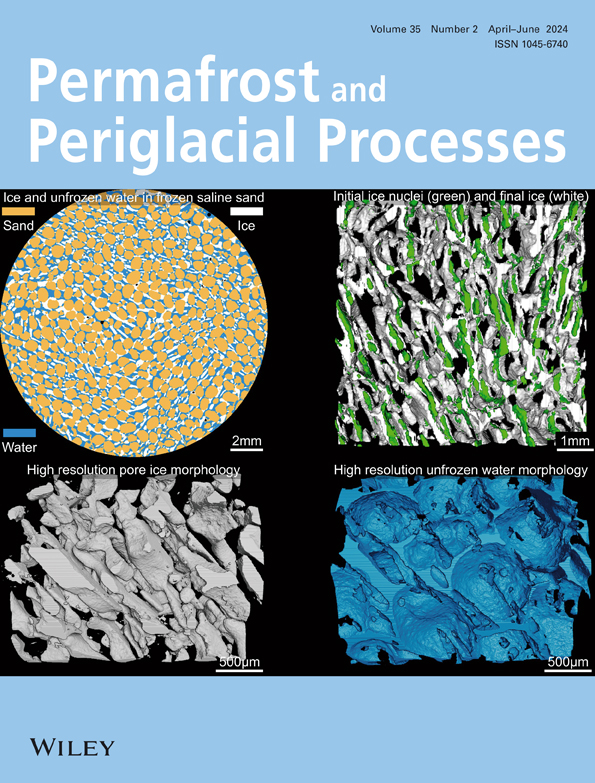青藏高原东北部冻土的高分辨率稳定同位素信号显示了冻土的冻融历史
IF 3.3
3区 地球科学
Q2 GEOGRAPHY, PHYSICAL
引用次数: 2
摘要
在评估气候变化中永久冻土的未来时,了解地面冰的形成机制和永久冻土的冻融历史至关重要。研究了青藏高原东北部黄河源区(SAIR)两个对比多年冻土剖面(P‐1,P‐2)4.8 m深度的高分辨率地面冰记录,整合了稳定同位素(δ18O、d‐过量和δ13C)、水化学(EC和pH)数据和低温地层学。结果表明,冰的稳定同位素和水化学在深度上存在显著变化。根据稳定同位素的变化和已知的现代活动层数据,对近地表地冰(NSGI)和深层地冰(DLGI)进行了表征。通过合成冻结过程中测量的δ18O和模拟的同位素分馏过程,我们认为P‐1中的NSGI和DLGI主要是由永久冻土沉积过程中的偏析机制形成的。然而,与DLGI的主要冰分离过程相比,P‐2中的NSGI表现出快速冻结的起源。通过将各种稳定同位素和水化学的演变与14C年龄数据相结合,确定了四个历史冻融阶段。具体而言,区分了一个解冻-再冻结阶段(2.8–2.2 m)、一个冻结-沉积阶段(2.2–1.6 m)和两个永久冻土沉积-退化循环阶段(4.8–2.8 m;1.6–0.7 m),强调了气候诱导的冻融转变和不同的永久冻土沉积过程对地面冰形成和由此产生的同位素水化学行为的重要性。这项研究首次使用地冰的高分辨率数据来解释SAYR中永久冻土的冻融历史。这些发现对于进一步了解QTP上过去的永久冻土演变和预测的未来永久冻土退化趋势具有重要意义,并为探索永久冻土历史提供了一种替代方法。本文章由计算机程序翻译,如有差异,请以英文原文为准。
High‐resolution stable isotopic signals of ground ice indicate freeze–thaw history in permafrost on the northeastern Qinghai–Tibet Plateau
Understanding the mechanism of formation of ground ice and the freeze–thaw history of permafrost is essential when assessing the future of permafrost in a changing climate. High‐resolution ground ice records, integrating stable isotopes (δ18O, d‐excess, and δ13C), hydrochemistry (EC and pH) data, and cryostratigraphy at a depth of 4.8 m from two contrasting permafrost profiles (P‐1, P‐2) in the Source Area of the Yellow River (SAYR) on the northeastern Qinghai–Tibet Plateau (QTP), were investigated. The results suggested significant depth variations in the stable isotopes and hydrochemistry of the ground ice. The near‐surface ground ice (NSGI) and deep‐layer ground ice (DLGI) were characterized in terms of variations in stable isotopes and known modern active layer data. By synthesizing the measured δ18O and the modeled isotopic fractionation processes during freezing, we suggest that both the NSGI and DLGI in P‐1 were mainly formed by the segregation mechanism during permafrost aggradation. The NSGI in P‐2, however, exhibited quick freezing origins compared with the predominant ice segregation processes for the DLGI. By combining the evolution of various stable isotopes and hydrochemistry with 14C age data, four historical freeze–thaw stages were identified. Specifically, one thawing–refreezing stage (2.8–2.2 m), one freezing aggradation stage (2.2–1.6 m), and two permafrost aggradation–degradation cycle stages (4.8–2.8 m; 1.6–0.7 m) were differentiated, which emphasize the importance of climate‐induced freeze–thaw transitions and differing permafrost aggradation processes on ground ice formation and resultant isotope hydrochemical behaviors. This study is the first to use high‐resolution data in ground ice to interpret the freeze–thaw history of permafrost in the SAYR. These findings are important for further understanding of past permafrost evolution and projected future permafrost degradation trends on the QTP, and provide an alternative method to explore permafrost history.
求助全文
通过发布文献求助,成功后即可免费获取论文全文。
去求助
来源期刊
CiteScore
9.70
自引率
8.00%
发文量
43
审稿时长
>12 weeks
期刊介绍:
Permafrost and Periglacial Processes is an international journal dedicated to the rapid publication of scientific and technical papers concerned with earth surface cryogenic processes, landforms and sediments present in a variety of (Sub) Arctic, Antarctic and High Mountain environments. It provides an efficient vehicle of communication amongst those with an interest in the cold, non-glacial geosciences. The focus is on (1) original research based on geomorphological, hydrological, sedimentological, geotechnical and engineering aspects of these areas and (2) original research carried out upon relict features where the objective has been to reconstruct the nature of the processes and/or palaeoenvironments which gave rise to these features, as opposed to purely stratigraphical considerations. The journal also publishes short communications, reviews, discussions and book reviews. The high scientific standard, interdisciplinary character and worldwide representation of PPP are maintained by regional editorial support and a rigorous refereeing system.

 求助内容:
求助内容: 应助结果提醒方式:
应助结果提醒方式:


